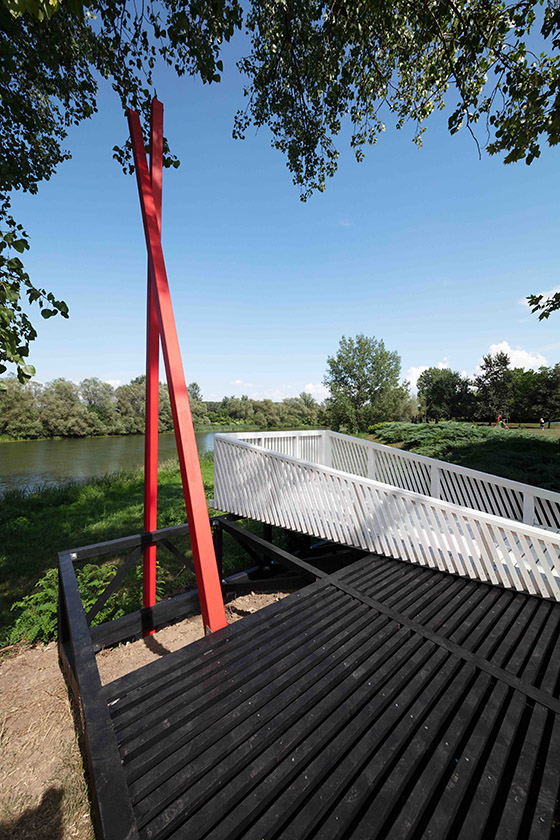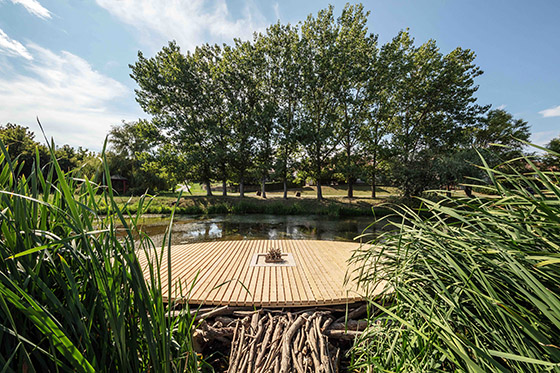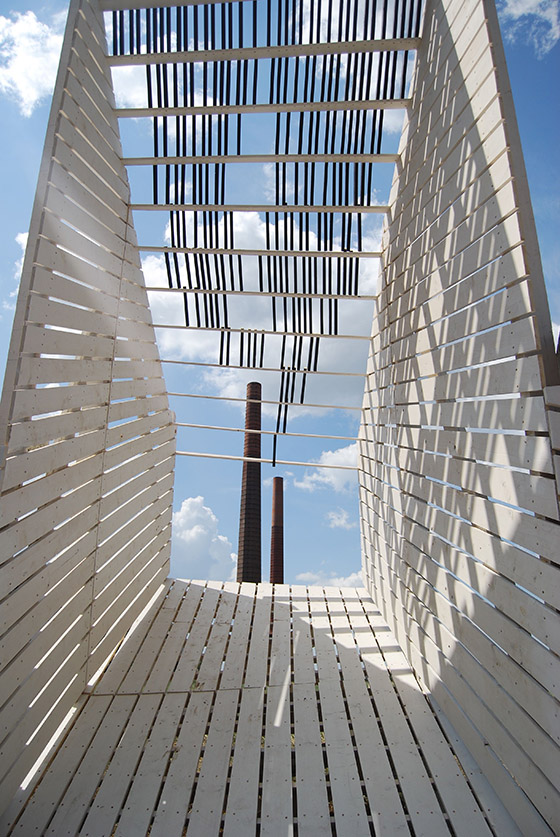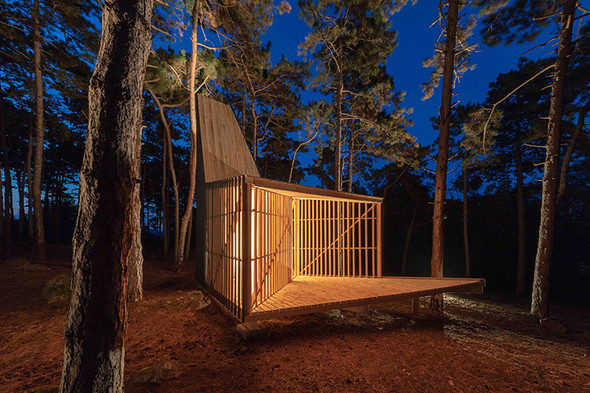Tokaj was home to the Hello Wood architecture exhibition 2018 for the second time this summer. Young Hungarian architecture and design students had the chance to try their hand at building their own wooden installations that highlight the most important places for the local community in the Tokaj wine region.
The Tokaj region generally rings a bell for wine lovers, but you can take a completely different approach to the wine region through the eyes of 150 young students camping here for a week as well as discover the region’s hidden treasures and stories.
One of the most memorable anecdotes for me is that of Fülöp (Philip) the white stork. Bodrogkeresztúr is a very popular place for storks, only one resided there the whole year round: Fülöp. A stork is a migratory bird, so it’s extremely rare that one will decide to stay put instead of migrating to Africa for the winter. Since Fülöp arrived from Spain on a nice spring day 13 years ago – hence being named after the Spanish King: Felipe VI – he has never left the village and soon became an animal mascot, loved and admired by the inhabitants of Bodrogkeresztúr. Even a running race was named after him, and he was also privileged enough to choose a mate or two from the first storks returning in spring. Sadly, Fülöp passed away this year, which is why the architecture students from the University of Pécs decided to create a memorial to him, a viewpoint constructed on the bank of the River Bodrog. With its red bill pointing up, this installation reminds visitors of beloved Fülöp.
Well, without Hello Wood, I would probably never have heard this story.

‘Bodrogólya (Bodrog stork)’ at Bodrogkersztúr – a memorial to Fülöp the white stork, a permanent resident of the village
Creator university: University of Pécs
Photo: Tamás Bujnovszky
What is Hello Wood?
Hello Wood is a Hungarian initiative which is an independent, international educational platform for design and architecture. It teaches young architecture students to think with their hands and learn through experience. All Hungarian universities offering architecture programmes participated in the project, together with the Hungarian University of Fine Arts this year.
The Hello Wood Architizer A+ Award-winning programme is included in participating universities’ curriculums. The one-week summer camp, where students build the wooden installations, is the final stage of a half-year seminar. The course involves visiting the regional sites of the installations beforehand, surveying local people's needs, drawing up blueprints and calculating the amount of building materials and tools necessary.
The aim of the educational programme is to tune in the undergraduates and their lecturers to the local characteristics with their unique features, natural, cultural and constructed heritage, as well as to cultivate centuries-old traditions while pursuing regional renewal with the fresh ideas of Generation Y. Finally, it aims to engender an understanding of the connection between wine and architecture.
How did the Hello Wood architecture exhibition 2018 end up in Tokaj? And how does it affect regional development?
Dávid Strommer, managing director at Tokaj Wine Region Nonprofit Ltd. which operates Tokaj Wine Region Development Council, the main supporter of the programme, explained to WineSofa:
Dávid Strommer (DS): The ‘joint thinking’ started two years ago, when we saw the installations from the Hello Wood project in Csopak, Lake Balaton, in the media. Dávid Héjj, the president of the Tokaj Wine Region Development Council sent me a message telling me that we should bring this excellent programme to Tokaj, and I had just been discussing the very same idea with my wife the previous evening. So, the pieces fell into place, and we agreed if we both thought the same way, it was time to act. I consulted Hello Wood’s website and called the contact person. Two weeks later, we were sitting in my office with Péter Pozsár, co-founder of Hello Wood; I had never expected that we would manage to begin a cooperation so soon.
WineSofa (WS): What does the Development Council hope to gain from this cooperation?
DS: Since we are responsible for the region’s development, the general wellbeing of the local community is a high priority for us. We have three main goals with the Hello Wood project:
- Firstly, to develop programmes which improve the quality of life for the region’s inhabitants.
- Secondly, to enhance tourism experience in the region and attract more visitors.
- And thirdly, to have increasing numbers of participating architecture and design students returning to Tokaj. We even see this happening from last year, as many students have come back to show their works to friends and family members.
We evaluated last year’s results in line with these expectations and were quite satisfied. It gives rise to hope, because we see the fact that the local community should be proud to live in the Tokaj wine region, a historic cultural landscape on the UNESCO World Heritage List, as a problem needing solving. These wooden installations might help to bring them closer to this, when, for example, they can sit on the dock made mostly of driftwood and enjoy talking to each other and watching the fire and the lake at Bodrogkisfalud.

‘Watching the water&fire’ at Bodrogkisfalud – Open fireplace and dock made from driftwood and metal
Creator university: MOME – Moholy-Nagy University of Art and Design Budapest
Photo: Tamás Bujnovszky
WS: This was the second year that Hello Wood has come to the Tokaj wine region. How many more years will it continue?
DS: Well, I always need to be very cautious with how I reply, because it mostly depends on the funding, but a very positive outlook would be two more years. So, all 27 municipalities would get a wooden installation. Last year, eleven projects were built in seven municipalities, and this year, they were supplemented by ten installations in eight municipalities: Bekecs, Bodrogkeresztúr, Bodrogkisfalud, Rátka, Szegi, Szerencs, Tarcal and Golop.”
Szerencs and the smoker
Finally, I’d like to present my other favourite, but less heart-warming, installation or story. For the architecture students of the University of Debrecen, the two chimneys of the former Szerencs sugar factory represent transiency, offering an impressive yet touching view at the same time. It is certainly true that the absence of the former factory is very present in the life of the Szerencs inhabitants even today. The students created an optical illusion next to the sugar factory’s fence which gives passers-by the impression that that the chimneys are puffing out smoke again. With this gesture, they managed to restore the past for a fleeting glance, but as soon as you pass the installation, it all fades back into history.

‘Smoker’ at Szerencs - The two chimneys of the former Szerencs sugar factory are puffing out smoke again
Creator university: University of Debrecen
Photo: Borbála Jandrasics






